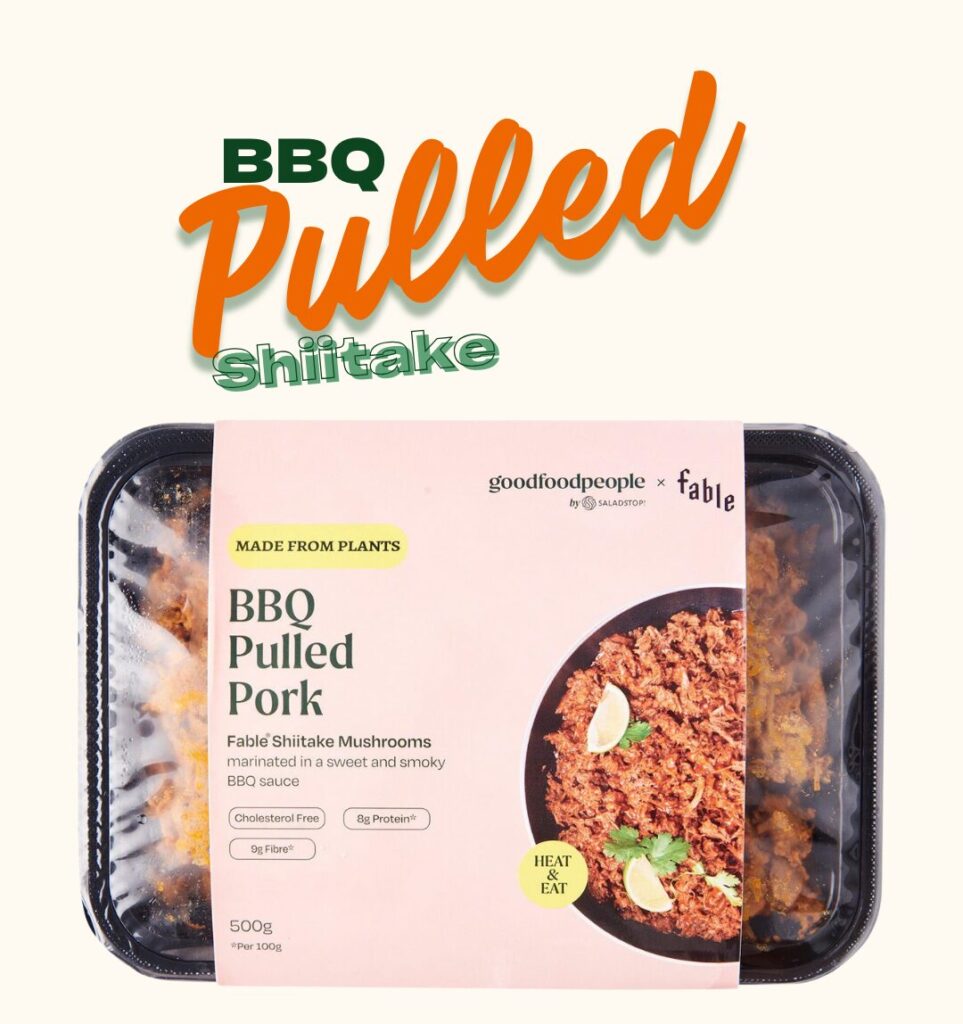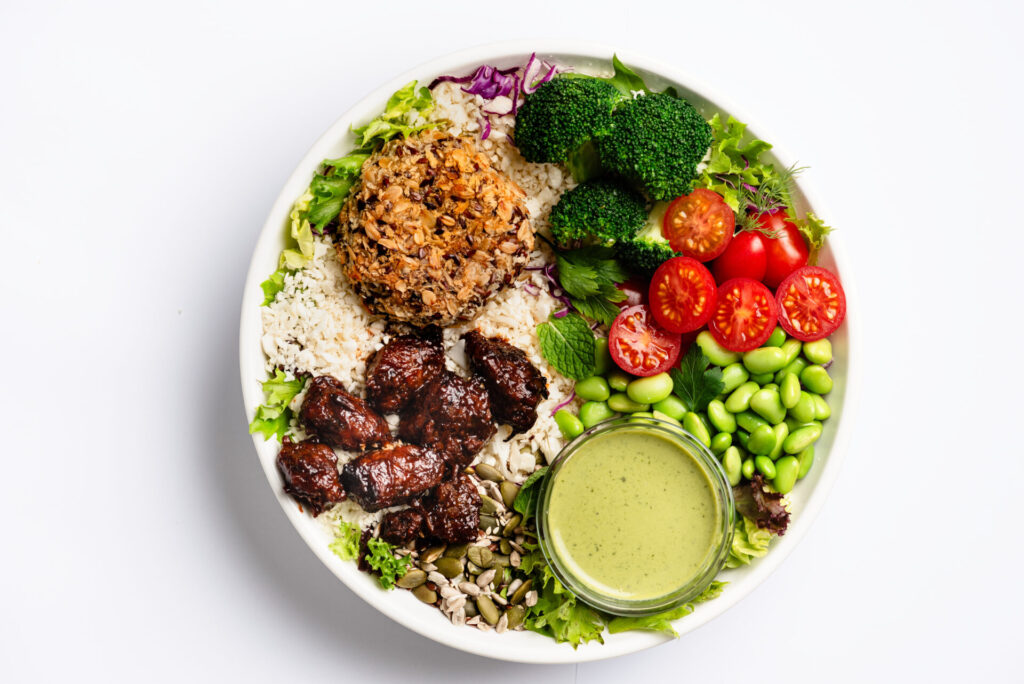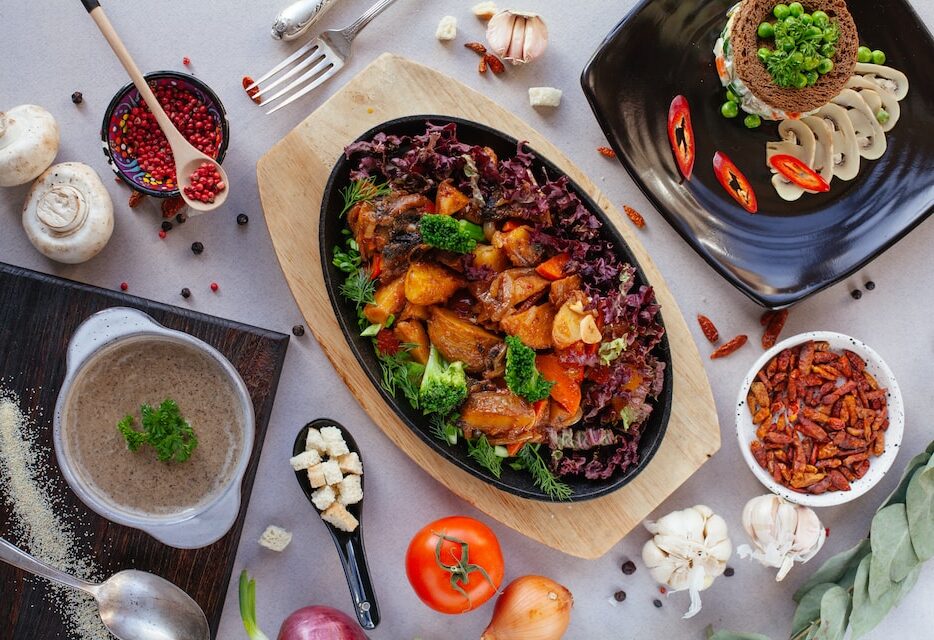Exploring the Nutritional Benefits of SaladStop!’s BBQ Pulled Shiitake

SaladStop! introduces a culinary marvel with its BBQ Pulled Shiitake, a dish that combines mouthwatering flavors with a wholesome nutritional profile. With each serving containing 5g of protein per serving of 60g, this plant-based option is designed to delight taste buds while nourishing the body. The foundation of the BBQ Pulled Shiitake is Fable, a brand known for its innovative use of mushrooms. This ingredient not only provides a meaty texture but also contributes a significant portion of the dish’s protein content. Coupled with pomace olive oil, the dish gains a dose of heart-healthy fats and antioxidants, enhancing its nutritional value. To infuse the BBQ Pulled Shiitake with its signature taste, SaladStop! incorporates HP Sauce and smoked BBQ sauce. These sauces add layers of flavor without compromising on health, ensuring a satisfying dining experience. Additionally, the inclusion of black pepper not only enhances taste but also offers potential health benefits, including improved digestion and antioxidant support. SaladStop!’s BBQ Pulled Shiitake epitomizes the brand’s commitment to providing nutritious and delightful options for its clientele. With its protein-rich base, beneficial fats, and flavorful sauces, this dish represents a harmonious marriage of taste and nourishment. Whether you’re a devoted vegan, a health-conscious eater, or simply seeking a gratifying meal, the BBQ Pulled Shiitake assures an culinary experience that caters to both body and spirit.
SaladStop!’s Hulk Patty: A Protein-packed Delight

SaladStop! introduces the Hulk Patty, a delicious and nutritious addition to their menu, designed to cater to the needs of health-conscious individuals seeking a protein-rich option. Packed with wholesome ingredients like rolled oats, soy milk, and a variety of vegetables, the Hulk Patty offers a satisfying culinary experience without compromising on nutritional value. Each serving of SaladStop!’s Hulk Patty (50g) provides approximately 4.8g of protein, making it an excellent source of this essential macronutrient. Let’s delve deeper into the nutritional components of this innovative creation: Protein: Complex Carbohydrates: Healthy Fats: Vitamins and Minerals: Gluten-Free Batter: SaladStop!’s Hulk Patty stands out as a nutritional powerhouse, offering a well-balanced combination of protein, complex carbohydrates, healthy fats, vitamins, and minerals. Whether you’re a vegetarian, vegan, or simply looking to incorporate more plant-based options into your diet, the Hulk Patty serves as a delicious and satisfying choice. With its innovative blend of ingredients and focus on wholesome nutrition, it’s sure to become a favorite among health-conscious consumers seeking a protein-packed culinary experience. Discover this Vegan Protein in our warm protein bowl, Game Changer!
6 Surprising Effects of Added Sugar on Your Health and Simple Tips to Cut Back

In our fast-paced world, convenience often means grabbing a quick bite or a sweetened drink. However, many of these easy choices come with a hidden cost: added sugar. This sneaky ingredient finds its way into numerous products, impacting our health in ways we might not expect. From disrupting our energy levels to affecting our mood and long-term well-being, the effects of added sugar can be far-reaching. In this article, we’ll explore how added sugar impacts our bodies and offer practical advice for reducing its intake in our daily lives. Whether you’re looking to make minor adjustments or major dietary changes, understanding the role of added sugar is a crucial step towards healthier living. The Basics When we eat sugar, it mostly breaks down and gets absorbed in our small intestine. Here, special enzymes change the sugar into three simpler kinds: glucose, galactose, and fructose. Our liver and muscles save some of the glucose as glycogen. This is a special kind of molecule that can change back into glucose when our body needs more energy. But, when glucose goes into our bloodstream, it makes the amount of glucose in our blood go up. To handle this, the pancreas makes insulin, which helps glucose move to different parts of our body where it’s needed. However, if we eat a lot of added sugar, our cells might start to ignore insulin. And this is when the problems start. Daily Recommendation It’s recommended to limit daily added sugar intake to no more than 100 calories for women and 150 calories for men. Health Implications Eating a lot of added sugars can lead to increased hunger. This is because sugar, while tasty, doesn’t fill you up, especially when it’s in foods that lack protein, fiber, and healthy fats. As a result, your body quickly burns through the sugar, leaving you hungry and prone to more snacking. Moreover, sugary drinks are linked to weight gain in both adults and children, but it’s not just about the extra calories. Added sugar can disrupt the balance of good and bad bacteria in your gut, affecting your metabolism and how your body processes fats and cholesterol. Additionally, sugar can interfere with hormones that control hunger, like leptin. This disruption can lead to increased cravings for sugar and more hunger. If you’re feeling moody or irritable, it might not just be stress; too much sugar could be the culprit. Studies suggest that added sugars can worsen mood and even lead to depression symptoms. A high-sugar meal can spike your blood sugar, but then it crashes, making you feel tired and grumpy. Also, when your blood sugar drops after eating too much sugar, it affects your brain, which needs stable blood sugar levels to function properly. If you find yourself getting irritable, especially after eating sugary foods, it’s worth looking at your sugar intake. Feeling tired and low on energy can sometimes be linked to the amount of sugar in your diet. Sugar provides a quick source of energy, but it’s used up fast. So, even if you eat a lot, you might find yourself hungry and low on energy again in about 30 minutes. Additionally, big changes in blood sugar and insulin levels, which can happen after eating sugar, can cause your energy levels to drop, affecting how energetic you feel overall. Too much added sugar in your diet might be a factor if you have high blood pressure. Studies have found a significant link between drinking sugary beverages and an increase in both high blood pressure and hypertension. Although a direct cause-and-effect hasn’t been established, what is known is that high levels of glucose can harm the lining of blood vessels. This damage makes it easier for cholesterol to stick, leading to hardened blood vessels and, consequently, higher blood pressure. A diet rich in refined carbs and sugary foods and drinks is linked to a higher risk of acne. Foods high on the glycemic index, like processed sweets, raise blood sugar faster than those with a lower glycemic index. Eating sugary foods can lead to spikes in blood sugar and insulin, which can increase oil production and inflammation, all contributing factors to acne. Studies show that low-glycemic diets may reduce the risk of acne, while high-glycemic diets may increase it. For instance, one study found that fatty and sugary products, sugary drinks, and milk were associated with current acne in adults. Additionally, population studies have observed that rural communities consuming traditional, non-processed foods have much lower acne rates compared to urban areas with diets high in processed and sugary foods. This supports the idea that diets loaded with processed, sugary foods may contribute to acne development. Diabetes has been rapidly increasing and is closely linked to sugar consumption. While sugar itself hasn’t been proven to cause diabetes, it indirectly raises the risk by contributing to weight gain and obesity, major risk factors for the disease. Moreover, high sugar intake can lead to insulin resistance, elevating the risk of diabetes. Studies specifically point out that people who drink a lot of sugar-sweetened beverages, including soft drinks and fruit juices, have a higher likelihood of developing type 2 diabetes. Easy Sugar Swaps Swap Soft Drinks for Sparkling Water: Replace Sweetened Soy Milk with Unsweetened Soy Milk: Choose Fresh Fruit Over Canned or Dried Fruit: Opt for Plain Yogurt Instead of Flavored Yogurt: Swap Milk Chocolate for Dark Chocolate: Use Natural Sweeteners Like Stevia Instead of White Sugar: Swap Sugar-Sweetened Beverages for Unsweetened Tea or Infused Water: Choose Whole Grain Bread Over White Bread: Opt for Homemade Dressings Over Store-Bought Ones: Swap Regular Breakfast Cereals for Unsweetened Oatmeal: Disclaimer: At SaladStop! Group, our commitment is to empower every individual with reliable, evidence-based nutritional and wellness guidance. To earn your trust as your ultimate resource for nutritional information, our content undergoes rigorous nutritional scrutiny to ensure its accuracy, whether it’s about our offerings, culinary creations, or services. Please note that all information provided is for informational purposes only and should not be
3 Tips to Losing Fat without Losing Weight

Losing weight is a common goal, but it’s important to know that not all weight loss is the same. The number you see on the scale doesn’t tell the whole story. While many people focus on losing weight, it’s actually more important to aim for a healthy and fit body by getting rid of fat while keeping your muscle. In this blog post, we’ll chat about the differences between losing weight and losing fat, dig into the science of body composition, and share some practical tips to help you lose fat without worrying about the scale. Body composition explained Your body is made up of two main parts: Now, why is this important when we talk about the difference between losing weight and losing fat? Here’s the deal: Muscle is more compact than fat. So, if you have a kilogram of muscle and a kilogram of fat, the muscle takes up less space in your body. Someone with more muscle and less fat might look leaner, even if they weigh the same as someone with less muscle and more fat. We also learned that your bones can get stronger and a bit heavier when you exercise regularly. Plus, your body’s water content changes throughout the day. Here’s the kicker: You can’t predict exactly how heavy or light your body will settle at when it’s comfortable because many things affect it. In simple terms, having a healthier body composition, which means more of the good stuff (muscles, bones, organs) and less of the not-so-good stuff (fat), doesn’t always mean you’ll weigh less on the scale. Body composition consists of fat mass and fat-free mass, including muscle, water, bones, and organs. Muscle is denser than fat, so two people of the same weight may appear differently if one has more muscle and less fat, emphasizing that a healthy body composition is about more than just the number on the scale. Remember: It’s about feeling good and looking fit, not just chasing a lower number on that scale. What is the difference between Weight Loss and Fat Loss? People often use “weight loss” and “fat loss” interchangeably, but they mean different things, and it’s more than just wordplay. Weight loss is simply the number you see on the scale. It’s the total of everything inside you, including bones, muscles, water, and yes, fat. So, when you lose weight, you’re shedding a bit of everything. Fat loss, on the other hand, means you’re specifically getting rid of the squishy stuff on your body – the fat. This can make you look smaller or leaner, but it doesn’t always make the scale go down. Here’s a neat trick: Sometimes, when you start a keto diet, you can lose a bunch of weight really quickly. But guess what? A big part of that is water weight, not fat. So, it might seem like you’re dropping lots of kilos, but it’s not necessarily fat disappearing. Now, why does this matter? Well, it depends on your goals. If you just want to be lighter on the scale, any weight loss might make you happy. But if you care about your health and how your body looks and feels, then focusing on losing fat is key. When your body has the right amount of fat, your risk of things like heart disease, stroke, and diabetes goes down. Weight loss involves reducing overall body weight, while fat loss specifically targets excess body fat. Be cautious of rapid weight drops on diets like keto, which can be mostly due to water loss, emphasizing the importance of discerning between the two for effective health and fitness goals. Remember: weight loss doesn’t always guarantee a healthier body. You could still have too much of that deep, visceral fat around your organs even if the scale says you weigh less. So, it’s not just about the numbers; it’s about where those numbers come from! Keto Diet and Water Weight Loss When it comes to the Keto Diet, it’s important to note that this eating plan induces ketosis in the body. This metabolic state leads to the burning of stored carbohydrates and the release of stored water, resulting in an initial rapid weight loss that is sometimes confused with actual fat loss. If you’re not on a keto diet but want to reduce water weight, consider reducing your sodium intake. Excessive salt consumption can cause your body to retain extra water to maintain the proper balance of salt and water. To lose water weight effectively, increasing water intake and reducing sodium consumption. Remember, reducing your water intake won’t safely help you shed this water weight. What can happen when you lose muscle in the process? When people lose weight, they sometimes end up losing not just fat but also muscle and fluids, which can have some not-so-great effects on their health. According to a study from 2018, losing lean body mass can lead to things like a slower metabolism, feeling tired, not moving as well, and even affecting how you feel emotionally. Plus, it might make you more prone to getting injured. On the flip side, having a good amount of muscle comes with some awesome perks like helping keep your blood sugar in check, keeping your body fat at healthy levels, and calming down inflammation. Plus, it lowers your chances of getting long-term health issues like heart problems, kidney troubles, and diabetes. When it comes to managing your weight in the long run, having more muscle is a big win. That’s because muscles burn more calories even when you’re just chilling on the couch or doing fun stuff like jumping rope. So, the more muscle you have, the more calories you torch with every activity – whether it’s an energetic workout or just relaxing! Remember, when you lose lean body mass, your metabolism can slow down, and you might end up gaining fat again and having a less healthy body composition! 3 Tips on how to lose fat and maintain muscle If you’re
Demystifying Plant-Based Protein for Endurance Athletes

Embarking on a marathon as a vegan athlete is a testament to the power of plant-based fuel. Gone are the days when animal proteins were seen as the only path to peak performance. Instead, we’re here to showcase how a well-planned vegan diet can meet and exceed the rigorous demands of marathon training, providing energy, endurance, and recovery in a sustainable, compassionate way. Whether you’re a seasoned vegan runner or looking to transition to plant-based nutrition as you train, this space is dedicated to providing you with the insights, recipes, and tips needed to ensure your diet is as robust as your running plan. From pre-run meals that energize to post-run foods that facilitate recovery, we’ll dive into the nitty-gritty of macronutrient balance, the importance of micronutrients, and the best vegan foods to fuel your endurance endeavors. 1. The Foundation Stage: Setting the Stage for Plant-Powered Endurance Embarking on your marathon journey begins with the foundational phase, a time that’s not just about lacing up your running shoes but also about embracing a robust plant-powered diet. It’s during this phase that the groundwork for future endurance is laid. While you might be easing into your training with gentle, low-intensity exercises, your nutrition should be anything but passive. Nourishing for Endurance: The Base Phase Dietary Strategy During these initial weeks, your body’s energy requirements will subtly rise as your activities increase. It’s the perfect opportunity to gently increase your intake by about 15-20% with a focus on whole foods: leafy greens, hearty legumes, and energy-sustaining starches. Pre-workout meals could include a banana with a swipe of almond butter, and post-exercise, a nutrient-packed smoothie. These small, strategic additions fuel your gradual increase in training intensity without overwhelming your system. 2. The Strengthening Stage: Building Speed and Power on Plants Once your base is established, you’ll shift into the strengthening phase, where your training picks up pace and power. Here, gym sessions will intensify, and endurance runs will stretch further. Your nutrition needs to step up accordingly. Eating for Growth: The Build Phase Dietary Focus With the heightened physical demand, your meals should start to reflect a higher proportion of calorie-rich foods to support muscle recovery and growth. It’s not just about more food, but smarter choices: proteins packed with amino acids, carbohydrates to replenish muscle glycogen, and fats for nutrient absorption. This phase isn’t about overhauling your diet but fine-tuning it to match your training’s intensity. Breakfast: Mid-Morning Snack: Lunch: Afternoon Snack: Dinner: Evening Snack: 3. The Peak Performance Stage: Priming for Race Day Approaching the race, you’ll enter the peak phase, a mix of intense workouts and essential rest periods to fine-tune your body’s preparation for the marathon. This is the culmination of your training, where all elements come together. Fueling for the Finish Line: The Performance Phase Dietary Plan Nutrition now becomes about precision: testing and perfecting the fueling strategies you’ll deploy on race day. The emphasis remains on balanced meals, now adjusted to support the rigors of your most intense training, with a slight uptick in protein intake to aid in recovery and muscle maintenance 4. The last stretch before the race is a balancing act: you might feel like going all out, but it’s time to ease up instead. You’ll reduce your training load to let your body rest up and build up its energy reserves for the big day. When it comes to food, now’s not the time for drastic changes. A gentle shift to include more complex carbs will help fill up your energy stores without overburdening your stomach. Think of it as carefully adding fuel to the tank, rather than flooding the engine. Integration and Adaptation: The Vegetarian Marathoner’s Edge Throughout each phase, the plant-based marathoner finds strength not just in the run but in the power of plant-based foods. Each step, each mile, and each meal is a building block towards not just finishing the marathon, but thriving through it. Vegan Meal Ideas: Vegan Snack Ideas: Disclaimer: At SaladStop! Group, our commitment is to empower every individual with reliable, evidence-based nutritional and wellness guidance. To earn your trust as your ultimate resource for nutritional information, our content undergoes rigorous nutritional scrutiny to ensure its accuracy, whether it’s about our offerings, culinary creations, or services. Please note that all information provided is for informational purposes only and should not be considered a substitute for professional medical or nutritional advice.

